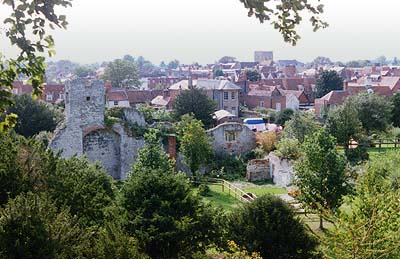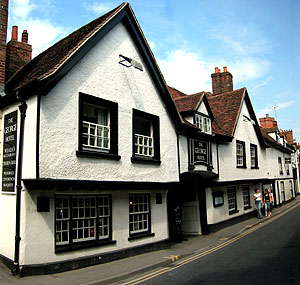 |
 |
|||
|
|
This was one of the Burghs established by King Alfred the Great in the ninth century. Some, like Wallingford, were 'new towns'; some were old Roman settlements; others were set up in Iron Age hillforts. All were carefully planned with precise street-grids and high fortifications. Wallingford had a stockaded bank, 3,300 yards long, that can still be clearly seen in places. Like other burghs, it appears to have had a church, St. Peter's, at one of its entrances, while St. Leonard's still incorporates some Saxon work in its walls. These places were centres of trade and habitation, but large areas appear to have been left vacant. This is explained by their other major use as places of refuge for the rural population during times of Danish attack. Like many of the Burghs, Wallingford also had a royal mint. It grew quickly and became the Saxon County Town of Berkshire. Its importance can be gauged from an interesting find from within the town walls: an ivory seal belonging to Godwin the Thegn. Bearded Godwin is featured below the seated Trinity trampling the Devil. The reverse has been reused by one Godgytha the Nun. It is unlikely to have had anything to do with the infamous Earl Godwin of Wessex, but almost certainly belonged to his contemporary, Godwin the Portreeve of Oxford. Before the coming of the Burgh, Wallingford seems to have been a small village of little significance which grew up beside an important river crossing. It probably had its own church though as St. Leonard's stands at a completely different orientation to the post-10th century town. The name is probably Saxon for "Welsh People's Ford", indicating that the area was largely a British settlement even after the Anglo-Saxons took over the country. Numerous finds of Roman coins date from 23 bc to AD 423 and there may even have been a temple to the Celtic hammer god, Sucellus, whose image has also been uncovered. However, an alternative Celtic reading of the name as Gual-hen-fforda or 'Wall(ed Town) by the Old Way' is still much less likely. After William the Conqueror had won the Battle of Hastings, one of the first places he made for was the fortified town of Wallingford, where the Saxon lord, Wigod, had supported his cause. While there, he received the submission of the Archbishop of Canterbury and attended the wedding of Wigod's daughter to one of William's favourites, Robert D'Oyley of Liseux. Twenty years later, the Domesday Book (1086) gives us an excellent idea of why the new monarch considered Wallingford important enough to be singled out for a visit. It was Berkshire's county town and the seat of the ruling Ealdorman. With a population estimated at between two and three thousand, Wallingford by far outstripped any other Berkshire town. It had possessed a mint for some years and was an important trading centre. Mention is made of both a Saturday market and twenty-two resident Frenchmen, who were no doubt merchants. It was also a manufacturing base with a number of smiths and probably other craftsmen. Though only one is mentioned in Domesday, we know that it also had fourteen churches and chapels! Between 1067 & 1071, D'Oyley had built himself a wooden motte and bailey castle in one corner of the town. He was an anti-religious land grabber, but changed his ways only when the prayers of Abingdon's monks made him ill! He founded Wallingford Priory soon afterward. D'Oyley's son-in-law was Brian FitzCount, the great supporter of the Empress Matilda, during the Civil War she instigated with her cousin, King Stephen. She fled here in 1141 after having finally abandoned her headquarters at Oxford. The townsfolk would have been badly effected by such loyalty and, during the three sieges of the Imperial stronghold, they may even have had to abandon their dwellings. Certainly, they had to put up with a large contingent of 'camp followers', as attracted by any military force, and it seems that health considerations, in the cramped conditions of the castle, forced the garrison to requisition a number of houses in the town. For the second siege, a make-shift fort was built by King Stephen's forces over the river at Crowmarsh Gifford, but it was during the third siege, in 1152, that the town saw most action. The King's men took Wallingford Bridge and the town and built a defensive wooden tower at the centre of the crossing. They may even have erected a second fort near the castle gates. The besieged garrison called for help from Matilda's son, Henry, the Duke of Normandy. By the Summer of 1153, he arrived from France with a large army and captured the bridge turret with a surprise attack. The King's men withdrew to Crowmarsh Gifford Castle and awaited reinforcements. King Stephen soon marched his army to meet the Duke and they agreed peace terms during a personal interview across the narrowest waters of the Thames! Soon, hostilities were brought to a complete end when the parties returned to Wallingford Castle, later that year, and signed the Treaty of Wallingford. The Duke was accepted as the future King Henry II and peace returned to the town and to the country. When Henry became King, he held his first great council meeting in the castle and rewarded Wallingford for its loyalty by granting its first charter of liberties (1155).
The later stone castle at Wallingford was one of England's most magnificent medieval palaces, as well as being a mighty stronghold. Royal owners were largely absent from daily Wallingford life, but Henry II's brother, Prince Richard, Earl of Cornwall & Holy Roman Emperor, made it his favourite home and he built the first stone bridge there across the Thames, parts of which still stand today. The castle was later favoured by the Black Prince and his wife, the Fair Maid of Kent, died there. Wallingford's inns and taverns must have been full to overflowing during Royal entertainments. The most remembered was a magnificent tournament, held at the castle, by Edward II's friend, Piers Gaveston, on the occasion of the announcement of his marriage. All the nobles of the land (and their retainers) were obliged to attend, even though they hated him! By 1416, construction of the bridges at Abingdon was completed and the road to Gloucester and the west was diverted through this Monastic town. The nails were being fixed into the coffin of Wallingford's success. Only twenty-three years later, the number of parish churches in the town had reduced to a mere four and in 1542, Leland describes a town not only in a state of decline, but of decay. Unemployment, through the lack of passing trade, had been considerably exacerbated by the Dissolution of the Monasteries, when the servants of Wallingford Priory were turned out on the street and the buildings demolished, over half the stone being used to repair Wallingford Bridge. The population shrank considerably and, by this time, large areas within the old Saxon Burgh - like the Kine Croft (opposite the Museum) - were being used as common grazing land. Only the traditional manufacturing trades of malting, cloth and leatherwork kept the town alive. During the Civil War, the castle was fortified for the King. Two heavy cannon were stationed in the town and parts of the bridge were demolished for the erection of protective drawbridges (only finally removed in 1751). Prince Rupert himself is said to have inserted the western gate in the Kine Croft Ramparts. The castle was the third to last Royalist stronghold in the whole country to fall. When finally captured after a sixteen week siege, Cromwell - who had briefly stayed at 'Cromwell Lodge' in the town - ordered it to be totally demolished. The castle ruins stand today within a lovely walled park, created by the Borough Council, off Castle Street. There is little in stone to see except the remains of the tower of St. Nicholas' Collegiate Church which stood within the castle walls. There are two small sections of other walls in the fields to the north, easily seen from the top of the castle motte. The whole area is very well laid out and has fine views of the town. In 1670, the market hall was built in the centre of the market-place. The stocks and a pillory stood at its western end until 1830. Perhaps a previous building had been destroyed during the Civil War. William of Orange visited the town on his way to London to take the English Throne as King William III in 1688. He was entertained at the Lamb Inn (now an antiques' centre) by its proprietor, Sylvanus Wiggins. However, Wallingford did not climb out of its impoverishment until the 18th century, when the local benefactor, Sir William Blackstone, helped establish two new turnpike roads through the town. He was a famous judge and author of 'Commentaries on the Laws of England', the first book to make the law of the land intelligible to everyone. Blackstone lived at Castle Priory House (now an hotel) , a fine Georgian building which, with such others as the pillastered Calleva House, show that the town's revival was a lasting one. Click for the Wallingford
Stop on the Berkshire Towns
Tour |
|||
| © Nash Ford Publishing 2004. All Rights Reserved. This location is now administered by Oxfordshire County Council. | ||||



 Wallingford
Wallingford Being
situated on the main London to Gloucester road, at the only Thames
crossing point for miles around, Wallingford's prosperity was always
assured and its recovery was swift. By the end of the 12th century, town
houses covered all of the old Saxon Burgh and there was probably a
considerable suburb outside the south gate. In the 1220s, there is
mention of a Guildhall, permanent shops and two separate markets for
corn and fish. The town's merchants built themselves fine homes and many
of Wallingford's timber framed buildings have medieval origins - like
the
Being
situated on the main London to Gloucester road, at the only Thames
crossing point for miles around, Wallingford's prosperity was always
assured and its recovery was swift. By the end of the 12th century, town
houses covered all of the old Saxon Burgh and there was probably a
considerable suburb outside the south gate. In the 1220s, there is
mention of a Guildhall, permanent shops and two separate markets for
corn and fish. The town's merchants built themselves fine homes and many
of Wallingford's timber framed buildings have medieval origins - like
the